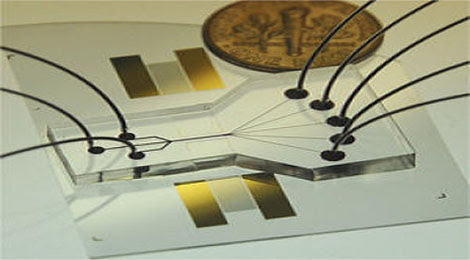A team of engineers has created an electrode for lithium-ion
batteries -- rechargeable batteries such as those found in cellphones
and iPods -- that allows the batteries to hold a charge up to 10 times
greater than current technology. Batteries with the new electrode also
can charge 10 times faster than current batteries.
New research could lead to rechargeable lithium-ion batteries that
hold a charge up to 10 times greater than current technology and that
charge 10 times faster than current batteries.
The researchers combined two chemical engineering approaches to
address two major battery limitations -- energy capacity and charge rate
-- in one fell swoop. In addition to better batteries for cellphones
and iPods, the technology could pave the way for more efficient, smaller
batteries for electric cars.
The technology could be seen in the marketplace in the next three to five years, the researchers said.
A paper describing the research is published by the journal Advanced Energy Materials.
"We have found a way to extend a new lithium-ion battery's charge
life by 10 times," said Harold H. Kung, lead author of the paper. "Even
after 150 charges, which would be one year or more of operation, the
battery is still five times more effective than lithium-ion batteries on
the market today."
Kung is professor of chemical and biological engineering in the
McCormick School of Engineering and Applied Science. He also is a
Dorothy Ann and Clarence L. Ver Steeg Distinguished Research Fellow.
Lithium-ion batteries charge through a chemical reaction in which
lithium ions are sent between two ends of the battery, the anode and the
cathode. As energy in the battery is used, the lithium ions travel from
the anode, through the electrolyte, and to the cathode; as the battery
is recharged, they travel in the reverse direction.
With current technology, the performance of a lithium-ion battery is
limited in two ways. Its energy capacity -- how long a battery can
maintain its charge -- is limited by the charge density, or how many
lithium ions can be packed into the anode or cathode. Meanwhile, a
battery's charge rate -- the speed at which it recharges -- is limited
by another factor: the speed at which the lithium ions can make their
way from the electrolyte into the anode.
In current rechargeable batteries, the anode -- made of layer upon
layer of carbon-based graphene sheets -- can only accommodate one
lithium atom for every six carbon atoms. To increase energy capacity,
scientists have previously experimented with replacing the carbon with
silicon, as silicon can accommodate much more lithium: four lithium
atoms for every silicon atom. However, silicon expands and contracts
dramatically in the charging process, causing fragmentation and losing
its charge capacity rapidly.
Currently, the speed of a battery's charge rate is hindered by the
shape of the graphene sheets: they are extremely thin -- just one carbon
atom thick -- but by comparison, very long. During the charging
process, a lithium ion must travel all the way to the outer edges of the
graphene sheet before entering and coming to rest between the sheets.
And because it takes so long for lithium to travel to the middle of the
graphene sheet, a sort of ionic traffic jam occurs around the edges of
the material.
Now, Kung's research team has combined two techniques to combat both
these problems. First, to stabilize the silicon in order to maintain
maximum charge capacity, they sandwiched clusters of silicon between the
graphene sheets. This allowed for a greater number of lithium atoms in
the electrode while utilizing the flexibility of graphene sheets to
accommodate the volume changes of silicon during use.
"Now we almost have the best of both worlds," Kung said. "We have
much higher energy density because of the silicon, and the sandwiching
reduces the capacity loss caused by the silicon expanding and
contracting. Even if the silicon clusters break up, the silicon won't be
lost."
Kung's team also used a chemical oxidation process to create
miniscule holes (10 to 20 nanometers) in the graphene sheets -- termed
"in-plane defects" -- so the lithium ions would have a "shortcut" into
the anode and be stored there by reaction with silicon. This reduced the
time it takes the battery to recharge by up to 10 times.
This research was all focused on the anode; next, the researchers
will begin studying changes in the cathode that could further increase
effectiveness of the batteries. They also will look into developing an
electrolyte system that will allow the battery to automatically and
reversibly shut off at high temperatures -- a safety mechanism that
could prove vital in electric car applications.
The Energy Frontier Research Center program of the U.S. Department of Energy, Basic Energy Sciences, supported the research.
The paper is titled "In-Plane Vacancy-Enabled High-Power Si-Graphene
Composite Electrode for Lithium-Ion Batteries." Other authors of the
paper are Xin Zhao, Cary M. Hayner and Mayfair C. Kung, all from
Northwestern.
From sciencedaily

























